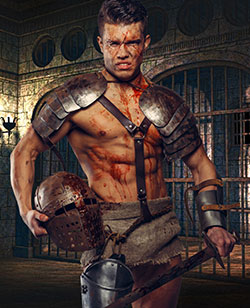There may not be mention of giants in the Gospels, but I did find a giant placed in the same time and approximate location of Christ’s ministry. One of my ancient resources has been the ancient Jewish historian Josephus. His rich text, Wars of the Jews, is the best ancient detailed source we have of the events that led up the destruction of Jerusalem and the holy temple in A.D. 70. Josephus is a non-Christian source that confirms Gospel details of Pontius Pilate, the Herods, John the Baptist, the apostle James, and even Jesus Christ.[1] Though his pro-Roman agenda is well-known, he nevertheless provides helpful factual information for the historical inquirer.
One of those interesting factoids is the reference to a 10 1/2 foot giant Jew named Eleazar who was presented as a gift to Tiberius Caesar in the presence of Herod Antipas, by the king of Parthia, Artabanus III in A.D. 33 or 34.[2]
“When Tiberius had heard of these things, he desired to have a league of friendship made between him and Artabanus… Artabanus and Vitellius went to Euphrates…And when they had agreed upon the terms of peace, Herod [Antipas] the tetrarch erected a rich tent on the midst of the passage, and made them a feast there. Artabanus also, not long afterwards, sent his son Darius as an hostage, with many presents, among which there was a man seven cubits tall [10 1/2 feet], a Jew he was by birth, and his name was Eleazar, who, for his tallness, was called a giant.”
[3]
Josephus doesn’t tell us if the Jewish giant was a servant or a captive, but he was certainly chattel of some kind to be traded as a means of diplomacy between the two empires. It occurred on the shores of the Euphrates in a tent constructed by Herod Antipas, the tetrarch of Galilee at the time. Antipas inserted himself into the negotiations in order to ingratiate himself to Caesar. All this, the reader will recognize occurring in Jesus Triumphant.
Vitellius, the king of Syria and representative of Caesar, brought the “gifts” of his son and the giant to Antioch, where they were presumably shipped to Rome.[4] But were they? Josephus doesn’t say. So, what if the giant Eleazar escaped? What if he found his short way down to Caesarea Philippi, where Jesus was during that last year of ministry? Thus the creative license of the novel applying to historical characters in a feasible scenario.

Jesus Bar Abbas. Zealot revolutionary leader of an insurrection in Jerusalem. Bet you didn’t remember that.
Barabbas
But that is not all the novel drew from historical characters. Many Bible readers know the name of Barabbas as the one who the Jews chose to release at Pilate’s offer instead of Jesus (Matt. 27:15-26). But what many casual readers of the Bible do not know is that Barabbas was a leader of a failed insurrection around that time in Jerusalem (Luke 2:19). He was no ordinary criminal. He was a zealot warrior, as he is in Jesus Triumphant.

Demas Samaris. A bestiaries who fights wild animals in the arena. He joins the Zealots to save his brother
The Thieves on the Cross
The two “thieves on crosses” next to Jesus are another case of commonly misunderstood identity. “Thief” or “robber” makes one think of common criminals or kleptomaniacs caught stealing camels or jewelry. But the Greek word for “thief” used of the two on the cross is lestai, the same word used by Josephus to describe the zealous Jewish brigands in revolution against Rome. Crucifixion was the punishment for such organized sedition and insurrection. The “thieves” on the cross were actually revolutionaries in the tradition of the Zealots.[5]

Though the existence of bands of Jewish insurrectionists against Rome at the time of Christ is not in dispute, the exact nature and chronology of the infamous Zealots is. Some have argued they did not come into existence until around the fall of Jerusalem,[6] but others have shown that they originated in Judas of Galilee’s failed insurrection of A.D. 6.[7] He made famous the slogan “No king but God,” that came to mark the Zealot cause.[8] Judas of Galilee’s sons, James and Simon, went on to be executed as zealous rebels around A.D. 46.[9] Josephus also describes two Zealot-like leaders Eleazar ben Dinai and Amram, who were captured and banished around A.D. 45 by Roman procurator Fadus. Another brigand leader, Tholomy was executed.[10] Eleazar was captured again later and executed in Rome in A.D. 60.[11] This means that James, John, Amram, Tholomy and Eleazar had been rising within the ranks of the newly growing Zealot movement during the time of Christ. Thus, their presence in Jesus Triumphant.
For additional Biblical and historical research related to this novel, go to www.ChroniclesoftheNephilim.com under the menu listing, “Links” > Jesus Triumphant.


One comment on “A Giant and Some Zealots in Jesus Triumphant”
There is MUCH mention of giants in the Bible!! Have no idea why the opening statements says there’s not???
Comments are closed.